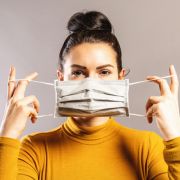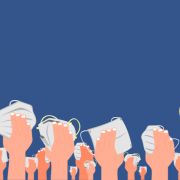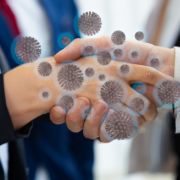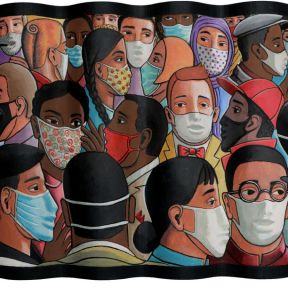
Coronavirus Disease 2019
The novel coronavirus set in motion a global pandemic that the world is still attempting to understand, treat, and grapple with.
The virus is a novel member of the coronavirus family of viruses, long associated with the common cold, SARS (Severe Acute Respiratory Syndrome), and MERS (Middle East Respiratory Syndrome). The virus is believed to have existed in animals before recently mutating and undergoing transmission to humans.
Because it’s a new virus, its behavior, its virulence, its means of spread, and other important features are only now under study. Infectious disease experts around the world are providing important information about the virus almost daily that can help curb its spread.
The virus leads to an illness called Coronavirus Disease 2019 or COVID-19. People with the disease typically have a fever, cough, trouble breathing, and exhaustion.
Most people who get the disease recover on their own with no lasting consequences, according to the World Health Organization. But up to 20 percent of cases may need urgent medical attention. Those most at risk include elderly adults and people with underlying health conditions.
Men appear to experience at least twice the risk of complications and death as women, and obesity as well as diabetes, heart disease, and immunologic conditions are reported risk factors for serious illness. Because the virus has a particular affinity for lung tissue, breathing can become compromised, and patients requiring hospital care often need the assistance of a mechanical ventilator, or respirator.
Simple actions like washing your hands, not touching your face, and staying home when sick can help keep everyone safe. Social distancing and avoiding large gatherings are also key to curbing transmission.
The novelty of the coronavirus threat, the uncertainty about its behavior, and the necessary adoption of restrictive measures to contain its spread, such as social isolation, have created unusual conditions giving rise to unprecedented levels of anxiety. Anxiety is an unpleasant sensation that normally serves as a stimulus to take appropriate action, but the very measures taken to curb the coronavirus require that people refrain from most forms of activity. As a result, the impact of anxiety is magnified and many people feel helpless.
Social isolation is a severe psychological and physiological stressor, and the stress of isolation is likely to hit hardest those people who, for one reason or another, are already devoting significant energy and resources to adapt to everyday life. These include, but are not limited to, the socially anxious, the unemployed, those with pre-existing mental health problems, those at risk for domestic violence and child abuse, elderly people coping with hearing or eyesight problems, and those experiencing cognitive decline.
Contents

As governments, corporations, and individuals work to contain the spread of the virus, it’s natural to experience stress or fear related to your health, your family, your job, and the economy. Although no one knows exactly what the next weeks or months will hold, many strategies can successfully address the anxieties that emerge during this time. These include physical steps, such as prioritizing sleep and staying active, and emotional support such as challenging unhealthy thoughts and calling family and friends.
As the pandemic continues to spread, anxiety does as well. Keeping calm is key to both mental health and immune function. Establishing a daily routine, checking the news during designated times, practicing meditation, and reaching out to loved ones are some of the tips that help keep anxiety in check.
Recognize the symptoms of stress—such as difficulty concentrating, irritability or sadness, and sleep problems—to know when and how to respond. Control what you can, such as following federal guidelines, but then try to release the concerns that you cannot control. Additionally, limit news consumption and practice self-care.
It's common for a job loss to feed anxiety and depression due to financial stress and the sense of control that's stripped away. Allowing yourself to grieve the loss and discuss feelings of anxiety with a loved one or mental health professional early on is key to preventing more severe symptoms of depression from setting in.
Don't panic, but do be pragmatic. If you've been laid off or furloughed, file an unemployment claim with the Department of Labor. Cut all non-essential expenses, establish payment plans for debts, and network for new jobs while being open to any type of work.
Researchers devised a 7-item questionnaire to try and quantify the nature of coronavirus anxiety. The survey includes items such as “It makes me uncomfortable to think about COVID-19” and “I cannot sleep because I’m worrying about getting COVID-19.” Early research suggests that a score of 17 marks the average anxiety level.

COVID-19 and the social distancing measures that followed have completely upended daily routines and family dynamics. Specific strategies can help you navigate the new normal, from soothing your children to keeping your pet safe.
Children may feel confused, angry, or restless during the outbreak. Here’s how to navigate their feelings and yours when everyone is under one roof: Validate difficult feelings, process emotions through play, and embrace structure and routine.
One strategy is to lean on your community. Assemble a group of parents who can each contribute one remote lesson, such as an English class or cooking demonstration. In addition to keeping kids engaged and social, this joint effort affords off-duty parents time to work, run errands, and keep up with household responsibilities.
Carve out specific times and places for everyone to do their work. After everyone is finished for the day, try to appreciate the old-fashioned family time everyone can spend together, such as watching one TV show or movie.
There have been no reports of pets contracting COVID-19, but until more information is available, people with the illness should avoid close contact with their pets, such as cuddling or kissing them. People can also establish emergency plans regarding their pets' care, food, and medication in the event of hospitalization.
Social distancing has erased the typical relationship cycle of periods apart and periods together. Being in the same place may require you to take space by working in different parts of the home. Recognize that both people may not cope in the same way, and step away when you’re upset, along with other measures.
It's natural for your sex life to take a hit during the lockdown. The first step to rekindling romance is to find effective strategies to cope with stress. Then schedule a romantic date night at home, or try something new, such as a new position, playing with a sex toy, or sharing a fantasy.
Giving birth during the coronavirus crisis can be deeply upsetting for some, due to the separation from parents, friends, and support. As you navigate this time period, allow yourself to grieve the loss of normalcy. Work on accepting the current situation and finding meaning with your new family.

Humans are innately social, and it’s difficult to refrain from seeing family, friends, and the people we simply pass on the street every day. Many are calling for social distancing to be reframed as “physical distancing,” in order to emphasize the importance of staying connected during this time.
Video-chatting with friends and family is key, and aim to schedule regular calls rather than single calls. Shift activities like book clubs and happy hours online. Immerse yourself in a fictional world, as characters can serve as “social surrogates.” Acts of kindness toward others can also alleviate loneliness by instilling a sense of connection and purpose.
Humans have a pervasive, evolutionary drive to be with other people—which can make social distancing incredibly difficult. Maintain your relationships by calling and video-chatting people you see regularly, and take advantage of the opportunity to deepen relationships with people who you aren’t as close with yet.
It can be difficult to replicate the ease of human connection over video-chat. Strategies like having a leader facilitate the discussion, acknowledging the difficult situation, and ensuring that everyone participates can be helpful for professional meetings, and sometimes personal calls, too.
The elderly are especially vulnerable to the psychological and medical risks of social isolation. In addition to people reaching out to their own relatives, local governments play a critical role in providing food delivery, medication, and transportation to necessary appointments.
The pandemic has prompted some people to reconcile with estranged loved ones, according to anecdotal reports. This may be due to a sense of anticipated regret or “socioemotional selectivity”—when the feeling that life is short prompts people to focus on relationships.

Within any challenge, there are opportunities. There is no question the COVID-19 pandemic has generally raised anxiety levels the world over, but for substantial subsets of those with chronic mental health conditions, the coronavirus crisis has provided opportunities for a radical shift of mindset or perspective that has eased the burden of disorder or ameliorated it altogether.
For many, having to meet day-to-day survival demands of the epidemic—ensuring a healthy food supply, maintaining sanitary routines, staying up-to-date on health-related information—has relieved painful self-focus or provided distraction from insecurities and obsessive thoughts to give the mind a healing rest.
For nearly everyone, a world suddenly turned upside down forces the need for rapid problem-solving and the forging of new relationships, life patterns, and perspectives on ways of doing nearly everything.
The disruption of the coronavirus crisis can serve as a stimulus for growth, summoning people to marshall personal resources that can work on their behalf long into the future. Responding to the crisis as a challenge to be mastered can lead to the enhancement of capabilities and confidence that psychologists observe as post-traumatic growth.
Widespread directives that people fight the epidemic by staying home have given many people, such as perfectionists, permission to reset expectations of themselves. Studies show that for others, the lack of many everyday distractions opens the door to learning how to tolerate negative emotions; such self-regulation is considered one of the most important life skills.
The very nature of the epidemic has removed the possibility of control, a goal that is always elusive but nevertheless pursued by many, usually at high psychic cost to themselves and others around them.

Therapy sessions are typically conducted face to face, but the COVID-19 outbreak is pushing therapists and clients to adapt. To keep therapy going strong, many are turning to video-chat apps or phone calls. Even remote conversations can produce effective treatment, but if this is the first time planning an online session, there are some details worth considering.
There are steps you can take to prepare for your sessions. These include testing out the app or software you’ll be using, making sure you have enough privacy during your session, and limiting distractions by closing other apps or websites. You’ll want to know your therapist’s contact information and preferred means of payment, too.
Your therapist may refer you to someone who can provide therapy remotely for as long as is needed. If not, many other therapists offer remote sessions. If you don’t want to see a new therapist, you can ask your therapist about books, online resources, and activities that can help until your next session.
Certain therapies seem to be just as effective when delivered over the phone. One study found that cognitive behavioral therapy was equally successful in treating depression when administered by phone or face-to-face, and fewer people discontinued therapy over time.

To maximize social distancing, more and more companies are asking employees to work from home. In many locations, it is now required by law that nonessential workers stay home, meaning that those who are able to work remotely must do so.
Even in the best of times, transitioning to working from home can be a major adjustment. In the midst of a pandemic, added anxiety and novel distractions—such as children attending school from home, too—have made the shift more challenging than ever. Adopting strategies to minimize distractions, as well as accepting that perfect productivity may be out of reach during this stressful time, can help individuals adapt to their new worklife.
Establish a clear structure to your workday and draw distinct boundaries between work and other areas of your life. This means setting up a dedicated workspace (if space allows), starting and stopping at set times, and “getting ready” each day—showering, getting dressed, and having breakfast—before starting work.
Transitioning to remote work provides the opportunity to test out new workstyles and strategies. Experiment with different time management and collaboration strategies—such as planning out a weekly schedule or setting up a daily check-in with coworkers—to identify ways to become more productive.
Many workers are under tremendous personal or economic stress. Managers can help by being transparent about any challenges the company will face, allowing for greater flexibility and autonomy, and providing opportunities for social connection (such as video meetings) to help reduce feelings of loneliness or anxiety.
Focusing on work while your mind is buzzing with anxiety can be immensely challenging. Remind yourself that feeling anxious right now is normal. Limiting news exposure, practicing healthy habits, and being kind to yourself can soothe anxiety and help reset your focus.
The onslaught of online meetings can be exhausting because the brain is working to decode information about many people at once, not just the speaker. We also gravitate toward looking at ourselves, which prevents us from being fully engaged. To address this fatigue, have fewer meetings, be selective about social engagements, and periodically switch to phone calls.

Extraordinary events can provoke some unusual or even baffling responses from human beings. In the wake of this outbreak, we’ve seen everything from frantic mass purchases of toilet paper and hand sanitizer to blatant flouting of public health warnings and rules about social gatherings. The biases and heuristics long studied by psychologists could help explain these phenomena.
The tendency to play down the risk of unusual events, or normalcy bias, may be responsible for continued social congregation in spite of expert advice. For some, however, catastrophic thinking could lead to going beyond recommended precautions or overreacting to signs of potential danger.
The pandemic led to a scramble in some countries to stock up on toilet paper and other goods, apparently triggered by people’s reactions to other people’s behavior in an instance of the bandwagon effect. The urge to eliminate even small risks (such as running out of toilet paper) may have contributed, too.
Efforts to raise alarm and push people to change their behavior in accordance with health guidelines are potentially useful if done carefully and with clear solutions provided. Some people—such as peers or familiar experts—may be more persuasive in these efforts than others.

Following the guidelines put forth by the World Health Organization and the Centers for Disease Control and Prevention is critical so that everyone stays safe. From hand washing and social distancing to boosting the immune system, individuals can take plenty of concrete steps to maintain their health.
Identify when and why you unconsciously touch your face, such as during periods of boredom or stress. Address those triggers by keeping something in your hand to fidget with, such as a beaded bracelet, or by putting your hands between your legs to make touching your face more difficult.
Keep your immune system strong by getting plenty of sleep, exercise, and eating nutrient-rich foods like leafy greens and fruit. Stress hormones can tax the immune system, so soothing your stress can help as well.
Data from other outbreaks, including SARS (also a coronavirus) indicates that in the medical profession where one study was conducted, some people perceived that they were shunned by colleagues.

Viruses, including the coronavirus, are transmitted via coughing, sneezing, and exhaling, uncontrollable behaviors that increase transmission from person to person. People can contract the virus through droplets expelled into the air or by touching a surface with those droplets and then touching the eyes, nose, or mouth.
Research suggests that each person with the novel coronavirus spreads it to two to four new people. If left unabated, the number of cases then grows exponentially. This trend is exacerbated by the fact that many COVID-19 cases are mild, so individuals may not yet know they are infected.
The goal of quarantine, social distancing, and other restrictive measures is to slow the spread of the disease so that the number of cases does not overwhelm the health care system. This concept is known as flattening the curve. In practice, however, this process is messy and difficult. It’s challenging for individuals to grasp how the small actions they take may influence the overall progression of the pandemic.
Almost everyone with the virus passes it along to a few new people. If the number of infected individuals continues to double unconstrained, the prevalence of cases rises exponentially.
The term coronavirus means that the virus referenced is a member of the family Coronoviridae. The specific coronavirus with which we're currently struggling is named SARS-CoV-2. The disease the virus causes is called COVID-19. A pathologist answers 8 basic biology questions here.
A longstanding hypothesis holds that viruses may make people more outgoing and social than they normally are in the earliest stages of the illness.














